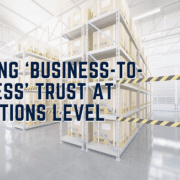The Softer Side of Trust Building
When looking at literature on B2B trust and empirical evidence on building a trust based relationship, I identified drivers which fall into two distinct categories:
HARD: the processes, systems and ways of working we can develop with our customers to drive and develop the relationship.
SOFT: the attitudes, behaviours and intentions we demonstrate in our every day customer interaction at all levels of the organisation.
Many organisations/institutions focus on the hard elements as it is easier to measure: ways of working mandates, systems, processes and technology. The softer elements appear more ambiguous and difficult to measure, and may often involve often people within the wider organisation/institution.
However, if you want to build trust, the softer drivers are critical triggers to developing good customer relationships.
Softer elements comprise of attitudes, behaviours, values and intention:
Attitude – How do you ensure the customer team comes to the relationship with a willingness and can do approach; that they put in just as much effort as you do to make it work? Are they positive, pro-active, suggest ideas for improvement? Are they open, honest and welcome constructive criticism?
The team needs to demonstrate predictability, reliability and competence; to indicate they understand the needs and wants to the degree that they can intuitively predict and act before an issue occurs or mitigate its impact when it does occur.
Behaviour – Is the customer open and transparent within the relationship? Are sales people willing to learn and work that extra 10% to deliver? Do they act as an extension of your business within the customer relationship, demonstrating the same approach, values and focus on quality? Do they constantly reassure us of their focus through; in customer activity, pics, notes, wins, comp info, and delivering on what they say?
Values – A good relationship works with a degree of tacit discretion. The people within the relationship are consistent: they do what they say, when they say it to the level required. The team network with a mutual development goal in mind. The two organisations have shared values and goals around areas such as community development , CSR, ethical sourcing, trade bodies, etc.
Intention – This concerns the positive and or negative intentions one organisation has for the other in the form and conceptualisation of actions and foresight (future intentions) within the relationship – How do you look ahead from a mutual development perspective? It also requires empathy: Understanding that your business drivers may be different, but you can be empathic towards the other side’s business drivers. They may not always be met, but empathy enables you to keep the relationship moving forward. Within the relationship, the team demonstrate empathy for each other, inside and outside of their interactions.
I recently experienced a first hand example of how soft drivers work are critical to business development from the MD of a large FMCG organisation, who had lead his account and sales directors through a successful meeting with a national account customer which resulted in an agreement to jointly business plan for the following three years. This represented a significant breakthrough within the relationship. Two weeks later when the MD asked the sales director about follow-up, the sales director said: ‘I am just waiting for the account director to pull together our response from the meeting.’
You can imagine the MD’s response! Two weeks had lapsed since the meeting!
It would be difficult for the customer to feel this organisation walked the talk when it came to developing trust. The customer should have had a follow up from the meeting outlining the actions. By the end of the week he should have received a draft time-line and next meeting date, followed by a phone call from the sales director to ensure this met expectations and what else was required. Finally, a courtesy note to the MD, explaining the way forward and his/her role within the development of the joint business plan.
If, this was done, it would have demonstrated to the customer and internal stakeholders the right attitude – which creates value for both sides. These four elements: attitudes, behaviours, values and intentions form the softer side of trust building, and if applied in a thoughtful, genuine and constructive way they will cement productive and fruitful relationships with your customers.
In our next blog we explore how you can pro-actively develop them.
If you would like to discuss this with Mark please contact us via Tweet to @customerattune or Tweet to @MarkHollyoake Or Contact us at hello@customerattuned.com
Read more blogs about Trust:
- Stop hiding behind your computer and get out to see your customers! - March 6, 2024
- B2B Trust Research: What are Boundary Spanners? - January 31, 2024
- A Business to Business Model of Trust - June 27, 2023


